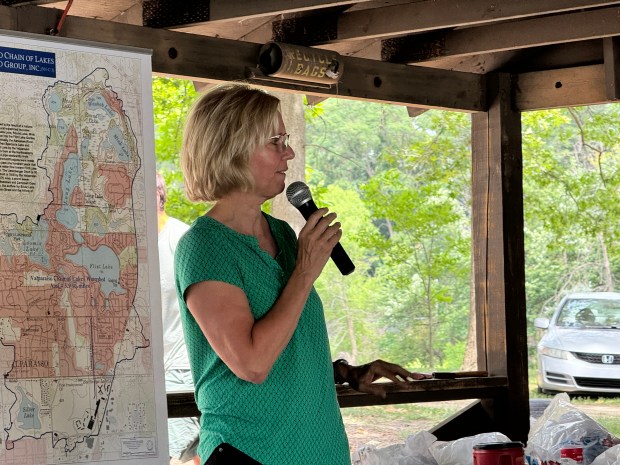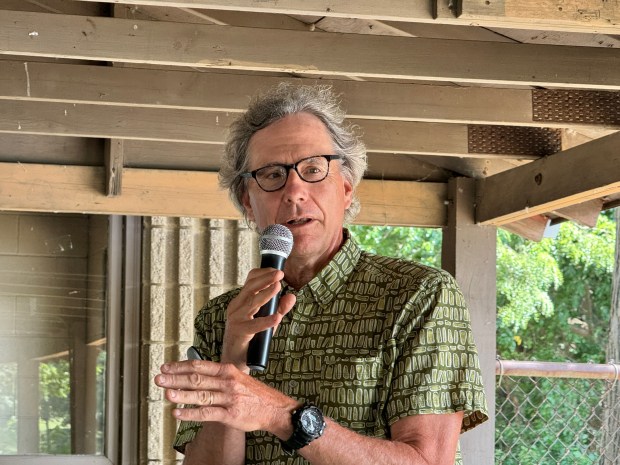The Chicago Wilderness region is home to some of the most biodiverse areas in the nation.
“How did we become the big kahuna of the ecology in the U.S.,” Indiana University Northwest biology professor Spencer Cortwright asked, then answered, during his presentation as part of the Living with Lakes seminar Saturday at Rogers Lakewood Park.
The seminar was sponsored by Valparaiso Chain of Lakes Watershed Group, which has a pro-environment focus.
The Chicago Wilderness footprint “is kind of an amoeba-shaped area from extreme southeast Wisconsin out through the western suburbs, around Northwest Indiana, into extreme southwest Michigan, and it’s all based pretty much on drainage,” Cortwright explained. Almost all the rain goes into Lake Michigan or the Illinois River.
For people who like the outdoors, there’s always something fun going on in the Chicago area, he said. Normally, you think of raptors as soaring through the sky, but northern harriers are a kind of owl that hovers like a helicopter, he said.
Then there’s the white-faced ibis, which found the 8,000-acre Kankakee Sands an exciting place. And those are just two of the species that have staked claims on this area.
“There are about 400 nature preserves in the Chicago area, so there’s no need to go on any vacations for nature further away,” Cortwright said. “We can do staycations all the rest of our lives in the Chicago area.”
“We have a half-million acres of dedicated nature preserve” serving 9.5 million people, he said.
Depending on how you do the calculations, the Chicago area could be the most biodiverse area in the country. If it’s not there, it’s really close.
Grand Canyon National Park has 1.2 million acres and 1,500 plant species. Indiana Dunes National Park’s 15,000 acres have about 1,130 native plant species alone. Throughout the Chicago region, there are 1,867 plant species in natural areas that add up to 500,000 acres, less than half the size of Grand Canyon National Park, Cortwright said.
“There’s some taxonomic uncertainty as to which ones are real species, but let’s take 300 out we still win,” he said. “And we have good production because we don’t have a long dry season like the Grand Canyon does, so we could debate that. And this is found throughout the Chicago wilderness.”
Lydick Bog near South Bend, owned by Shirley Heinze Land Trust, has fewer than 200 acres but over 500 native plant species, Cortwright said. “The next time you go visit your relatives in California, ask them to take you to a nature preserve of only 200 acres that has at least 500 species of plants, and they won’t find it, probably.
Creek Ridge County Park near Michigan City is even smaller, with 112 acres, and has 430 native plant species. “You could just keep doing this over and over and over,” he said. “I got chills on my legs there.”
If you calculate the number of plant species per 10,000 square kilometers, areas with a lot of altitude do better than the relatively flat Chicago area, but our biodiversity still ranks among the best in the nation, Cortwright said.
This area has southern Lake Michigan to thank for its biodiversity. “We get weather influences from the north, the west and the south,” Cortwright said. “Plants that find home in the Gulf Coast or southern Appalachians do all right up here. We have hot, dry air masses from the west come in, so plants from the Great Plains find us OK. And then we get those northern blasts of weather come in.”
Soil types vary widely, too, adding to the region’s biodiversity, he explained.
In Cook County, there’s an “auto dealership hell here, a whole bunch of auto dealerships, sewage sludge drying beds, the Stevenson Expressway the Tri-State Expressway, and then some preserves,” Cortwright said. Theodore Stone Forest Preserve’s 142 is tucked in among them, featuring three major different habitats – a hilly, glacially deposited area that grows as a savannah, a prairie/lake area with tall grass, “and then like the Great Wall of China, but somebody took the wall away, it changes over to bedrock – exposed dolomite prairie with a whole bunch of new plants.”
“This little preserve that no one hardly knows about, but they drive by it every day, is one of the ecological gems of the Chicago area because it has those three different soil types in such a small area,” he said.
Human habitation makes a big difference in our natural environment here. “Lady slipper orchids were reportedly by the thousands in downtown Gary is and even beyond, but they’ve been relegated to just a few places,” Cortwright said.
Downtown Valparaiso used to be a bur oak forest, he believes. There is still a large bur oak tree on the courthouse lawn.
Charles Deam, Indiana’s first state forester, lived 1866 to 1953. He visited Clark and Pine Nature Preserve in Gary late in life and said, “I’ve collected in every township in the state of Indiana. I am now in my 80s. This is the finest Indiana natural area I have seen in my life.”
“If you ever do get a chance, go to Clark and Pine and ask the Department of Natural Resources biologist or whoever is leading the tour to point out some of the rare species in there,” Cortwright said. “I think there are more endangered species in this little nature preserve than anywhere else, possibly in the country. You’ll never go to a place there’s so many endangered species in such a small area.”
Maintaining natural areas means being vigilant toward invasive species.
“This September, we could spend a Sunday afternoon seeing if the Bears are any good. We know the answer to that already, but we’re going to spend three hours checking it out every Sunday. How about we go join a restoration crew in September and October and then if we hear through the grapevine they’re doing well on a gray, rainy November day, let’s watch them and see if they’re really good,” Cortwright said.
One of Saturday’s presenters, Emily Troisi, is last year’s winner of the Valparaiso Chain of Lakes Watershed Group scholarship. At Purdue University, she was part of a group looking at chronic effects of foams used to put out fires involving gasoline and other petroleum products for which water is unsuitable. The results aren’t out yet.
As an intern, Troisi was sent out into a bog wearing waders to capture mating pairs of frogs for the study as well as other messy but important tasks.
This year’s scholarship winner, Alyssa Supranet, is a chemistry and environmental science major at Valparaiso University. She spoke of introducing Galerucella beetles to feed on purple loosestrife as a means of fighting the invasive species. So far, the results look promising, but it’s important to watch for unintended consequences of deploying the beetles.

VU chemistry professor Julie Peller spoke about “forever chemicals,” ones not easily broken down into organic components. Their use is widespread, including for nonstick coating in cookware. “You wouldn’t believe how much of this stuff is in those microwave popcorn bags,” she said.
“When you think about these materials, they’re meant to be water resistant, really durable but super long-lasting, so widespread release into the environment, especially in areas of firefighting training,” Peller said. “In these areas, it’s contaminated a lot of the groundwater, the drinking water, so these are the kind of hot spots in the country.”
Sarah Powers, an environmental science professor at Indiana University, spoke of the Indiana Clean Lakes program, run through IU’s School of Environmental and Public Affairs. Biologists take water samples to determine lakes’ health. Volunteers are encouraged.
“Be that first line of defense to new invasive species,” she said. “If you know about these targeted ones that are a problem or of concern, you’re out there more often than the aquatic biologist who does your surveys for you. They only come out a couple times a year. You’re out there all the time, every day, so to be that first line of defense for our water bodies.”
Malena Ryan, a Valparaiso-based northern lakes biologist with Aquatic Control, gave the audience a primer on identifying plants that cause problems in area lakes.
Doug Ross is a freelance reporter for the Post-Tribune.




